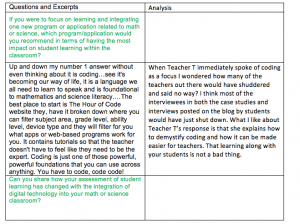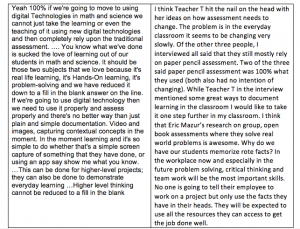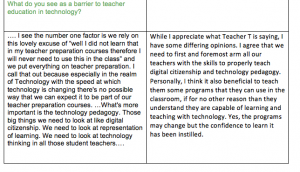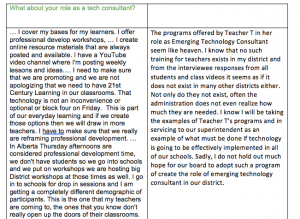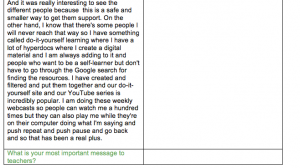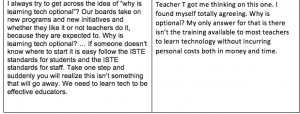Key Words: Apathy, Coding and Life Long Learning
For this activity, I actually ended up interviewing four teachers. Teacher C was a male eighth-grade math and science teacher (he has been teaching for 13 years), Teacher S is a retiring grade seven teacher who teaches math but no science (she has been teaching for 28 years), Teacher S2 is a 3/4 grade teacher who teaches both math and science (she has been teaching for 15 years) and finally Teacher T is a tech consultant.
What I found interesting first off with two of the three teachers was just the general apathy about technology. They used it mostly to show a video or have kids play a game. They seemed to think they were using technology well and had no real interest in investing their own time to learn more. If the school board provided opportunities during the school day then they would be interested. Neither of these teachers had invested any of their own money for training or equipment (not a judgement just a fact as the other two interviewees has spent money on their own equipment).
The third classroom teacher had self-initiated learning technology and had attended several workshops on their own time and at their own expense. They were most frustrated by the red tape that is needed to use any sort of technology not approved by the board and had spent a lot of time with paper work to unblock sites or add drivers only to be denied by the board office. This teacher mentioned how she invested in a device to add to an iPad to be able to save student work. The driver needed to be added to the iPads so that it could be used. It was not allowed by the board, and she expressed exasperation at the fact that her students continue to be frustrated by lost work.
All three teachers felt that there was not enough training by the board to implement technology and that they were frustrated by blocked sites and inaccessibility to apps. While the board has been investing in hardware there is no training to go along with this. The staff have all been given Chromebooks but no in-servicing. One teacher used hers, of the other two one was locked in a drawer, the other had been leant to an Educational Assistant to use. All agreed they knew the Chromebook could be a powerful tool but they had no idea how to use it effectively.
Note: In terms of the interview questions I had prepared I found myself adjusting these as the interviews took place, teachers answers often covered more than one of my questions and repeating it as another question seemed redundant.
The fourth interviewee Teacher T is the interview I will share here, (the other three interviews will be available on my e-profile later this week). I specifically chose to interview this Teacher because of their own evolution of technology use, as well as, the opportunities that they make available to the staff of their school district.
Teacher T Interview
Teacher T has been teaching for about 15 years in the Edmonton School System. She spent several years as a classroom teacher and then a teacher in a designated special needs room. She has spent the last two years as an Emerging Technology Constultant and loves the job. I met teacher T through the MET program. We have collaborated on several projects and keep in touch outside of the MET forum. Teacher T was an enthusiastic participant in the interview. The interview took place over Google Hangouts (we screen videoed the session and used Google Docs with voice typing to keep track of the notes). The interview took place at 9pm Ontario time on a Thursday evening.
What prompted you to begin integrating digital technology into your classroom and how has your use of digital technology developed since you began?
Okay, so actually this one’s a really important one because I was one of those stereotypical teachers that was terrified of technology.
I really didn’t use it other than when I was forced to check my email and I would like Google stuff to find out the answer. What I mean is I could use the internet that was about it. All of that changed because about eight years ago I moved from the regular class to a severe special needs program. It was a group of 14 students at a time and grades 4 5 and 6 chronologically but academically about K to grade 1 and I went in the room and tried to teach you like you teach anybody. Let’s shove intervention down their throats, you know keep giving them more books and more practice and more worksheets and I was feeling miserable and at the time I was pregnant. Thank goodness I was going on maternity leave. I really struggled with that classroom and what was interesting was while I was gone on mat leave they had installed a smart board without even telling me and I cried because I realized I was one of those who teachers didn’t have a clue what I was doing to do.
That was the 180 change in me, I decided I was going to actively integrate technology purposefully in this class. It really felt like this was going to be the linchpin that could be the Difference Maker to these kids. So I did a ton of research and really looked at how I could do a different program. I realized nobody around me was doing it differently, if I was going to do this I had to be really going to war with it.
I started with Twitter because if there’s any place to find up to the minute information about how to use technology it was going to be there and in the back channels I found this thing called a Raspberry Pi and I thought okay okay I can do this. You build your own computer and learn to code and finally, I convinced myself I’m going to do this so I went to a teacher’s convention session on Raspberry Pi and I made my husband who’s a teacher come with me because I didn’t want to go alone. When we arrived the speaker pulled me aside and said you know this if for Raspberry Pi I think you are in the wrong room. And I said no I’m here for Raspberry Pi and when I turned around I realized I was the only girl in the room in a sea of male high school science teachers. I just decided to try my best so I went in that room and I was the first person to build my computer was the first person to unpack the new software and it was a changing point for me. I decided no more being afraid and so I dug into coding and using a physical computer with the Raspberry Pi, it was perfect because while I was teaching my students I was learning it so my student really transformed they started to build a computer. I had a student who couldn’t spell his name right and yet he built a computer and maybe he couldn’t write a story but damn if couldn’t put together some awesome graphics. My students went from being terrified, terrified of death by Papercut to computer builders. From there we moved on to Minecraft, to the Makey Makey we started hacking things for a classroom to make a night vision camera to discover what nocturnal animals do at night. We made our guinea pig take selfies using tin foil and some celery and you know the Makers Space and robotics meeting changed them and changed me and I never looked back so from there. I love building computers, I honestly just got a Raspberry Pi 3 today. I work with emerging technology every day and it excites me.
If you were to focus on learning and integrating one new program or application related to math or science, which program/application would you recommend in terms of having the most impact on student learning within the classroom?
2. Up and down my number 1 answer without even thinking about it is coding. it’s one of those things that’s quickly becoming a new leader, see it’s becoming our way of life, it is a language we all need to learn to speak and is foundational to mathematics and science literacy. All of it regardless of whether you are four years old or you’re in high school and coding is easily accessible by anyone, anywhere. The best place to start is The Hour of Code website they, have it broken down where you can filter subject area, grade level, ability level, device type and they will filter for you what apps or web-based programs work for you. It contains tutorials so that the teacher doesn’t have to feel like they need to be the expert. What is fantastic is they will learn along with the kids. You know it starts with simple things like Anna and Elsa from Frozen and they create snowflakes in the ice and what’s really amazing is that you are learning measurements, learning angles, you are learning all of this mathematics. I actually had a teacher well you’re not supposed to learn angles until grade 6, that’s in our grade 6 program of studies here in Alberta and I thought let this kid use angles! Coding is just one of those powerful, powerful foundations that you can use across anything. You have to code, code, code!
Can you share how your assessment of student learning has changed with the integration of digital technology into your math or science classroom?
3. Yeah! 100% if we’re going to move to using digital Technologies in math and science we cannot just take the learning or even the teaching of it using new digital Technologies and then completely rely upon the traditional assessment. We have got to move away from paper-based assessments. To really capture the base level Knowledge and Skills only with paper in math and science isn’t going to work. Why do we give a kid a list of 30 questions? If they could do it after 5 we know they can do it. You know what we’ve done is sucked the love of learning out of our students in math and science. It should be those two subjects that we love because it’s real life learning, it’s Hands-On learning, it’s problem-solving and we have reduced it down to a fill in the blank answer on the line. If we’re going to use digital technology then we need to use it properly and assess properly and there’s no better way than just plain and simple documentation. Video and images, capturing contextual concepts in the moment. In the moment learning and it’s so simple to do whether that’s a simple screen capture of something that they have done, or using an app say show me what you know. Have them going through a demonstration or whether you’re using a Chromebook and you’ve installed the extension screencastify and it’s them explaining, hey teacher here is how I do this and I’m moving manipulatives. This can be done for higher-level projects, they can also be done to demonstrate everyday learning instead of filling in the blanks on this worksheet let them play the game online and record themselves using screencastify and then talk about it. Higher level thinking cannot be reduced to a fill in the blank
What do you see as a barrier to teacher education in technology?
4. Teacher education whether in pre-service training or in-service training is like the idea of the murder on the Orient Express.The whole idea of that was there were many different facets that that came together to cause this problem. I see the number one factor is we rely on this lovely excuse of “well I did not learn that in my teacher preparation courses, therefore I will never need to use this in the class” and we put everything on teacher preparation. I call that out because especially in the realm of Technology with the speed at which technology is changing there’s no possible way that we can expect it to be part of our teacher preparation courses. Because by the time you graduate it is no longer relevant. What’s more important is the technology pedagogy. Those big things we need to look at like digital citizenship. We need to look at a representation of learning. We need to look at technology thinking in all of those student teachers. The actual technology it is going to change, is going to change, is going to change… because that is the nature of technology.
What about your role as a tech consultant?
I’m an emerging technology consultant I’m part of a team of 5 for 90 schools 40 000 students, 3000 teachers and I have to make sure how I cover my bases for my learners. I offer professional develop workshops, I make sure I cover the cost of Subs are coming into class and workshops, I create online resource materials that are always posted and available. I have a YouTube video channel where I’m posting weekly lessons and ideas. I have to make sure that I’m providing those learning opportunities for teachers Teachers need to take ownership of that which they need to learn but I can’t take a horse to water and make them drink. I need to make sure that we are promoting and we are not apologizing that we need to have 21st Century Learning in our classrooms. That technology is not an inconvenience or optional or block four on Friday. This is part of our everyday learning and if we create those options then we will draw in more teachers. I have to make sure that we really are reframing professional development. That’s been a goal of mine this year but number one with this is going to come down to the leadership and administration. I am going into this school tomorrow to do a Google workshops following up from PD that I did and the principal is providing internal coverage so that two teachers at a time can come and ask me anything they want about Google based on where they’re at in their learning. We also make sure that we provide schools for half-day sub release cost. In Alberta Thursday afternoons are considered professional development time, we don’t have students so we go into schools and we put on workshops are we hosting big District workshops at those times as well. I go into schools for drop-in sessions and I am getting a completely different demographic of participants. This is the one that my teachers are coming to, the ones that you know don’t really open up the doors of their classrooms. And it was really interesting to see the different people because this is a safe and smaller way to get them support. On the other hand I know that there’s some people I will never reach that way so I have something called do-it-yourself learning where I have a lot of hyperdocs where I create a digital materials and I am always adding to it and people who want to be a self-learner but don’t have to go through the Google search for finding the resources. I have created and filtered and put them together and our do-it-yourself site and our YouTube series is incredibly popular. I am doing these weekly webcasts so people can watch me a hundred times but they can also play me while they’re on their computer doing what I’m saying and push repeat and push pause and go back and so that has been a real plus.
What is your most important message to teachers?
I always try to get across the idea of “why is learning tech optional”? Our boards take on new programs and new initiatives and whether they like it or not teachers do it because they are expected to. Why is learning tech optional? In Alberta, part of our teacher mandate is to be life-long learners. The mission statement doesn’t say to do what we have always done, it states to be life-long learners. We need staff to embrace this and learn tech. If someone doesn’t know where to start it is easy to follow the ISTE standards for students and the ISTE standards for staff. Take one step and suddenly you will realize this isn’t something that will go away. We need to learn tech to be effective educators.
Catherine
